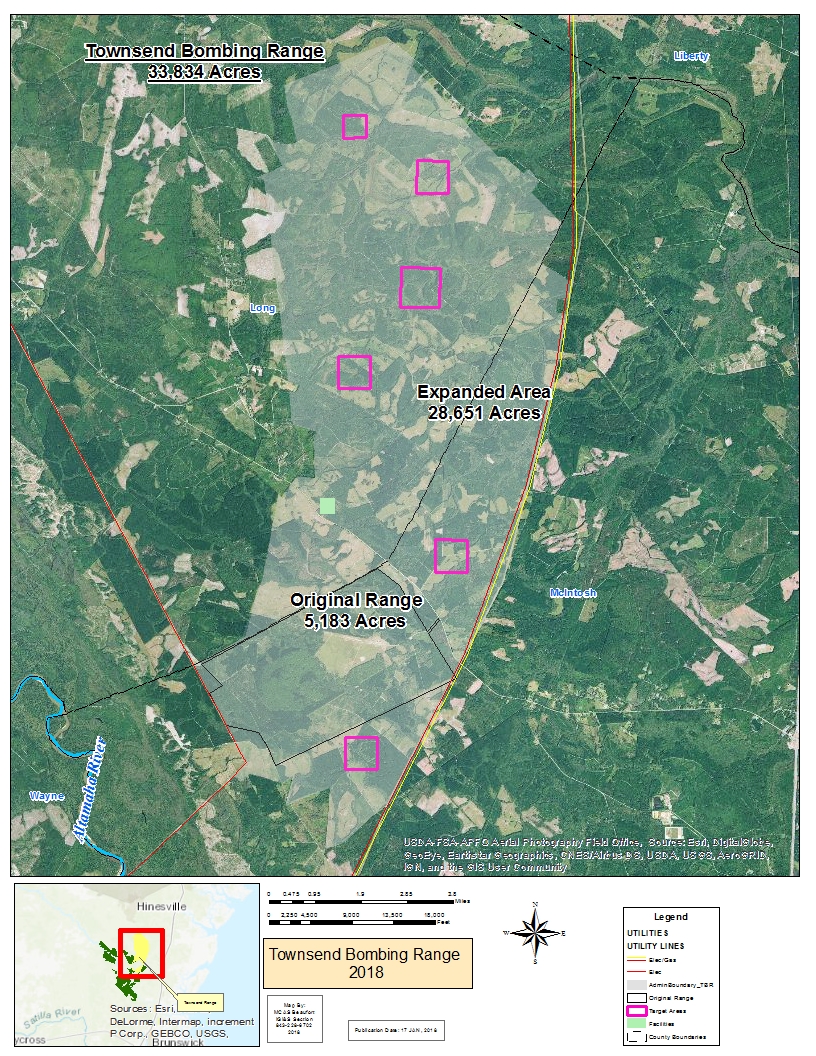Range Operations
Townsend Bombing Range's published operating hours are Monday through Saturday 7:00 AM – 10:00 PM. Training or operational necessity can result in extended operating hours or days and/or temporarily suspend operations. Any times outside of published operating hours are coordinated with the Federal Aviation Administration by Notice to Airmen with at least 24 hour notice.
About Townsend
Townsend Bombing Range is the East Coast’s premier air-to-ground training range. It provides the nation’s aircrews access to world-class training, which is critical to maintain a strong national defense in a world of ever-changing opponents, battlegrounds, and technologies. Located in Long and McIntosh Counties in southeast, coastal Georgia, Townsend Bombing Range is 82 miles southwest of MCAS Beaufort. It is the primary air-to-ground training range for aviation units stationed at MCAS Beaufort, home to Marine Aircraft Group 31. In addition to being an essential training asset to Marine Corps aviation units, Navy, Air Force and Air National Guard, and Army units from more than six states also train at Townsend Bombing Range and its complex of Special Use Airspace. The Marine Corps’ flight controllers at Townsend Bombing Range direct military aircraft to the target area where inert (non-explosive) munitions are delivered to simulated military targets. Inert munitions contain a small spotting charge that activates upon impact to help score the run. Highly sophisticated scoring equipment locates the proximity of the munitions’ impact to the target. Pilots also conduct low-angle strafing training (shooting at large “bulls-eye” targets set up on the range), and close air support training exercises.

History
Townsend Bombing Range was established in 1940s as Naval Air Station Glynco Bombing Range with 3,882 acres and closed in 1972. The Marine Corps re-opened the range in 1981 and the land was transferred to the Marine Corps in 1991. The Georgia Air National Guard operated the range until operational responsibility transferred to the Marine Corps in October 2017. Recently expanded from 5,183 acres to 33,834 acres, Townsend Bombing Range is being modernized for training operations. Until the modernization is complete, Townsend Bombing Range will continue to facilitate training in the current impact area.
Modernization and Expansion
As modern combat and warfare technologies evolve, the training ranges that prepare the nation’s aviators must also adapt to meet and anticipate these changes. Marine Corps aviators must train and be highly skilled in multiple mission areas, which include the delivery of precision-guided munitions and other air-to-ground weapons against a range of target types. Precision-guided munitions are a modern class of weapons that permit Marine aviators to attack specific threats and isolate targets. Until Townsend Bombing Range is fully modernized, the Marine Corps’ East Coast ranges cannot accommodate realistic precision-guided munitions training. As a result, in order to train to the level required by the Marine Corps, the aviators stationed at MCAS Beaufort deploy to the West Coast of the United States to use the training ranges in the desert of California and Arizona. The modernization and expansion of Townsend Bombing Range to accommodate training with inert precision-guided munitions will significantly enhance the efficiency of East Coast aviation unit training, and enable more appropriate utilization of the nation’s other training ranges.
Environmental Impact Sheet
This page contains information and documents from the National Environmental Policy Act (NEPA) process, including the Environmental Impact Statement (EIS) for the Proposed Modernization and Expansion of Townsend Bombing Range, Georgia, completed in March 2013, and the subsequent Record of Decision (ROD), signed by the Department of the Navy (DON) in January 2014. Learn more here.
Mission Sustainment
A significant amount of Townsend Bombing Range training occurs at low altitudes. Certain kinds of development in the special use airspace could degrade training or otherwise be in conflict with uses of the range. Incompatible uses include obstruction of low-level flight, lighting of the night sky, electromagnetic interference, loss of habitat for protected species, or noise concerns for proposed residences. The Marine Corps works closely with the Georgia Department of Natural Resources, The Nature Conservancy and many other partners to protect over 54,000 acres near Townsend Bombing Range through the Department of Defense Readiness and Environmental Integration (REPI) program (http://www.repi.mil). In addition to protecting the quality of training, the REPI projects protect and provide habitat for many sensitive species, such as the gopher tortoise, eastern indigo snake, shortnose sturgeon, and more.
Contact Information
The Marine Corps remains committed to working with neighbors and stakeholders. Please contact MCAS Beaufort’s Office of Communication at (843) 228-7225 with any questions.